| Welcome to Garden Zone, a monthly newsletter for anyone interested in gardening. It's produced by Extension Master Gardener volunteers in Mecklenburg County. View in your browser In the Piedmont area, November is the time we enjoy the fall leaf colors. It’s also the time when we see our first frost. Here are some tasks for your garden: ✳️ November is an ideal time to plant or transplant trees, shrubs and groundcovers. Be sure to water thoroughly, then mulch the new plants with a good 2- to 3-inch layer of mulch. ✳️ Newly planted evergreens should be checked regularly during the winter to ensure they are getting enough water. ✳️ Mulch existing trees and shrubs to reduce weeds, provide insulation from freezing temperatures and conserve moisture. ✳️ It’s a good time to check trees and shrubs in your yard for “volcano” mulching - mulch piled high around the base or trunk of the plant. If found, pull back the mulch from the trunk and create a “donut” instead – little or no mulch against the base or trunk of the plant. A heavy layer of mulch around the base can lead to girdling roots as well as foster insect, disease, and rodent problems. ✳️ Take root cuttings now of woody shrubs and evergreens, like azaleas, hollies and hydrangeas. ✳️ Cut back peonies after the first frost. It’s also a good time to plant asparagus crowns and strawberry plants. Finish planting onion sets and garlic. ✳️ Cut cannas right above ground level and remove the debris to avoid over-wintering leaf rollers. ✳️ Don’t forget to remove all dead foliage and clean up vegetable and flower beds after the first killing frost. Apply new mulch or plant a cover crop, if desired. ✳️ Fescue lawns (a cool season grass) should be fertilized mid-month (about the time the grass is green but not actively growing). If you have Bermuda (a warm season grass), if the lawn is not overseeded in the winter, raise the mowing height 1⁄2 inch to protect it from winter kill. Meet a Master Gardener Carol Hickey, a 2020 Extension Master Gardener class graduate, and Tarah Cherry, a 2022 graduate of the EMG program, met as parents at Chantilly Montessori School. As part of the school curriculum, each classroom at the Chantilly Montessori School is blessed with two raised garden beds in addition to a sensory garden, butterfly highway and memorial garden. Carol’s many years volunteering as the gardening parent for her sons’ classrooms inspired her to become an Extension Master Gardener volunteer. She wanted to ensure that she was utilizing the best practices and, in doing so, teaching the students, teacher and other parent volunteers those techniques. Tarah was inspired to become an EMG volunteer by observing Carol’s dedication to the school gardens. Beyond being a support for the teachers, Carol loves observing the therapeutic benefits of bringing students outside and how through gardening she can teach life lessons, like learning to complete tasks. She plans to continue her gardening education by taking therapeutic horticulture classes. Tarah enjoys working with students and watching the lightbulb of understanding ignite in a student’s eyes that they can grow food, or that they enjoy the taste of a new vegetable that they may have never tried before. Together with the flowers and plants in the school gardens, Carol enjoys growing vegetables and herbs. Tarah’s favorite thing to grow by far is kale, but she also enjoys growing other greens, rosemary and sage. In addition to her work in the school gardens, Carol enjoys sharing information with the public and helps with the library stands. Photo courtesy of EMG Amelia DeAngelis Russell Why The Fall Color? There is no mistaking autumn in North Carolina. Simply look to the color in your backyard or stroll down one of the many neighborhood streets in Charlotte adorned with maples, hickories, and capacious oak trees putting on brilliant shows of color! But what causes the leaves to change then drop, and how can we take advantage of this in our landscape? The shortening day lengths, combined with chilly nights and sunny afternoons, trigger the breakdown of chlorophyll production in leaves. Chlorophyll is the pigment that allows for photosynthesis and gives leaves their green color. When production of chlorophyll breaks down, the remaining pigments in the leaves show through. The scarlet reds produced by sourwoods are the result of anthocyanins, pigments formed when sugars are trapped in leaves on cool nights. Pigments like carotenoids and flavanols, hidden by chlorophyll in the summer, produce brilliant displays of yellow and orange in species like birch, hickory, and maple. Coinciding with the changing color, deciduous trees send a hormonal response triggering their leaves to fall off in preparation for winter. These fallen leaves then become excellent habitat for wildlife or the perfect landscaping mulch for your garden. Enjoy! Photos courtesy of EMG Gina Tadle Nandina Nandina, or ‘Heavenly Bamboo,’ is a lovely plant with many virtues. It has pretty berries, a graceful form, and is evergreen. However, we are discouraged from planting it and encouraged to remove it from our yards. Nandina is listed in the Invasive Plant Atlas of the United States and is regarded as invasive throughout the Southeastern United states. Not only is it considered to be a non-native invasive plant, but the berries contain arsenic and can kill birds if they eat too many. When I moved to Charlotte, which was a new ecosystem for me, our house had a hedge of nandina across the front porch. I loved it! But as I learned more, I started removing them, which turned out to be not that easy. If you dig them up, they will return from specks of roots left behind. New volunteers continue to pop up in my shrubbery in the wooded area of my yard, justifying for me their inclusion on the list of invasive plants. If you succeed in removing yours (a dab of herbicide on the cut stump seems to do it) and you still want a shrub with berries, our native Winterberry Holly is a good choice, as is our native American Beautyberry. If you choose to keep your Nandina, please consider cutting off the berries so the birds don’t eat them and the plants won’t spread. Photo courtesy of EMG Stacy Hodes Turmeric This popular spice from the Indian subcontinent that lends a typical yellow color to anything it is added to, comes from the rhizome of the Turmeric plant. At first glance, the plant looks a lot like Canna. Hardy in Zone 8 and above, it is a fuss-free plant that does well in varying sunlight availability - from dappled sunlight, partial shade to full sun. The genus name 'Curcuma' is Latin, from the Arabic word 'Kumkum or Saffron'. It acquired the name because the color of the plant's rhizome resembles Saffron. But the two plants couldn't be more different as Saffron is the filament of the Saffron Crocus! Turmeric belongs to the family Zingiberaceae - where yet another popular spice, Ginger, comes from. Ginger is more commonly used fresh, unlike Turmeric which is more popular in its powdered form. Both have incredible anti-inflammatory properties and their medicinal usage can be traced back thousands of years, as mentioned in Ancient Ayurvedic remedies. Both of the plants are very easy to start, even from grocery store produce. Simply bury the rhizomes shallowly (it doesn't matter which side up) in late spring once the soil is workable, and green growth will be visible above ground after about 6 to 8 weeks. Enjoy growing these plants, both for their looks as well as their medicinal uses. Photos courtesy of EMG Parul Srivastava Peonies - Caring and Sharing Your herbaceous peonies have brought you such beautiful blooms this season but now the plants are starting to look a bit sad. They are ready for their long winter’s nap! The first thing you will want to do is remove and destroy the old mulch around the plants to fend off diseases. Leave the plants unmulched during the winter. They need exposure to cold temperatures to bring on blooms next season. Then, after the first frost, remove stems down to 3 inches from the surface of the soil to help avoid fungal diseases. If you have plants that are 10-15 years old and you are ready to share with friends, this is the best time to divide them. You will want to gently dig around the plant so you don’t cut any roots. Peonies have tubers so, with a sterilized sharp knife, cut sections containing 3 to 5 eyes. It’s good to treat each cutting with a fungicide to avoid disease. If you want to introduce peonies into your garden or just need more information, we've provided additional resources. “ A rose is a rose, but a peony is a friend forever.” Author unknown Resources: NC State - Peonies for the Home Landscape Instructional Video from Thompson and Morgan - How to Plant Peonies Photos courtesy of Stacy Hodes and Pixabay Tucking in Plants for the Winter Porch plants soon become houseplants again as winter approaches. Here are some tips for successful transitions. Freshen up potted plants. Trim excess growth, especially if plants became too large for your indoor space. Examine leaves for aphids, mealy bugs, and white flies. Remove all mulch to be sure no frogs are lurking. Using a mild dishwashing soap solution, dunk small plants. Spray top and bottom of leaves of larger plants. It’s fine to let soap drip into the soil. Scrub the pot or repot. Start cuttings for next year. 4-inch cuttings of begonias and coleus, for example, can be rooted to enjoy over the winter; then, they are ready to plant outdoors in spring. Dig up geraniums. Shake the soil from the roots and prune any unhealthy stems. These can overwinter in paper bags or cardboard boxes and stored in a cool place that does not freeze (the top of an outdoor refrigerator, a crawl space, or a garage). Plants like hibiscus can be stored in their pots next to the geraniums. Mulch in-ground plants. |
Welcome to Garden Zone, a monthly newsletter for anyone interested in gardening. It's produced by Extension Master Gardener volunteers in Mecklenburg County.
| |
|
|
In the Piedmont area, November is the time we enjoy the fall leaf colors. It’s also the time when we see our first frost. Here are some tasks for your garden:
✳️ November is an ideal time to plant or transplant trees, shrubs and groundcovers. Be sure to water thoroughly, then mulch the new plants with a good 2- to 3-inch layer of mulch.
✳️ Newly planted evergreens should be checked regularly during the winter to ensure they are getting enough water.
✳️ Mulch existing trees and shrubs to reduce weeds, provide insulation from freezing temperatures and conserve moisture.
✳️ It’s a good time to check trees and shrubs in your yard for “volcano” mulching - mulch piled high around the base or trunk of the plant. If found, pull back the mulch from the trunk and create a “donut” instead – little or no mulch against the base or trunk of the plant. A heavy layer of mulch around the base can lead to girdling roots as well as foster insect, disease, and rodent problems.
✳️ Take root cuttings now of woody shrubs and evergreens, like azaleas, hollies and hydrangeas.
✳️ Cut back peonies after the first frost. It’s also a good time to plant asparagus crowns and strawberry plants. Finish planting onion sets and garlic.
✳️ Cut cannas right above ground level and remove the debris to avoid over-wintering leaf rollers.
✳️ Don’t forget to remove all dead foliage and clean up vegetable and flower beds after the first killing frost. Apply new mulch or plant a cover crop, if desired.
✳️ Fescue lawns (a cool season grass) should be fertilized mid-month (about the time the grass is green but not actively growing). If you have Bermuda (a warm season grass), if the lawn is not overseeded in the winter, raise the mowing height 1⁄2 inch to protect it from winter kill.
| |
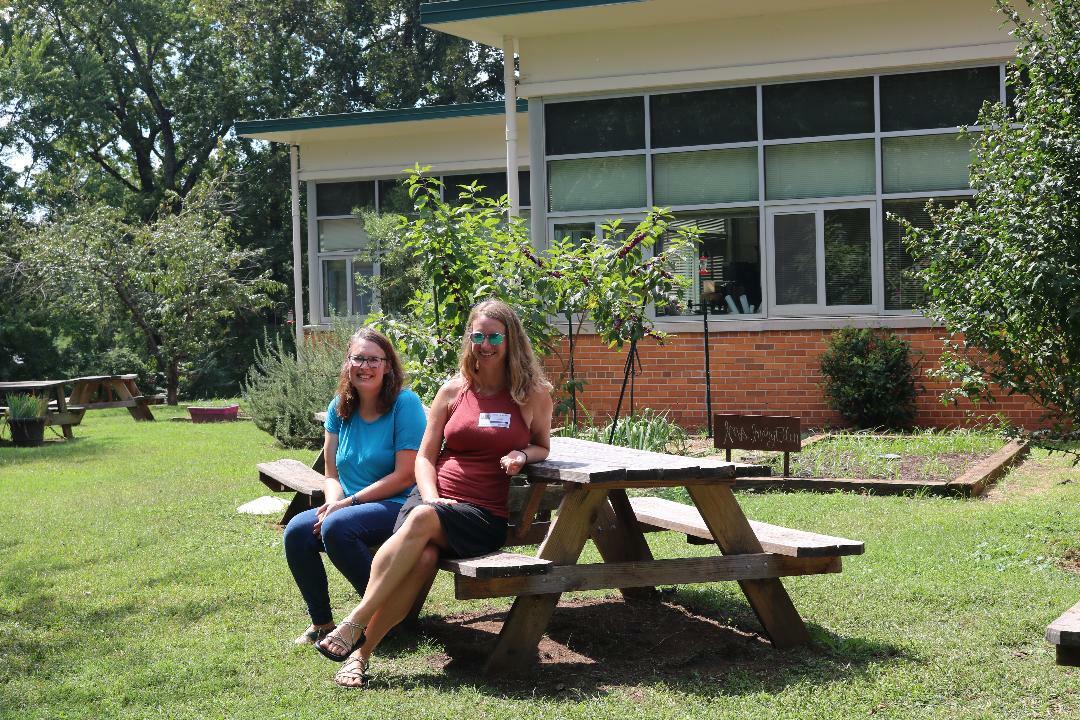 |
Carol Hickey, a 2020 Extension Master Gardener class graduate, and Tarah Cherry, a 2022 graduate of the EMG program, met as parents at Chantilly Montessori School. As part of the school curriculum, each classroom at the Chantilly Montessori School is blessed with two raised garden beds in addition to a sensory garden, butterfly highway and memorial garden. Carol’s many years volunteering as the gardening parent for her sons’ classrooms inspired her to become an Extension Master Gardener volunteer. She wanted to ensure that she was utilizing the best practices and, in doing so, teaching the students, teacher and other parent volunteers those techniques. Tarah was inspired to become an EMG volunteer by observing Carol’s dedication to the school gardens.
Beyond being a support for the teachers, Carol loves observing the therapeutic benefits of bringing students outside and how through gardening she can teach life lessons, like learning to complete tasks. She plans to continue her gardening education by taking therapeutic horticulture classes. Tarah enjoys working with students and watching the lightbulb of understanding ignite in a student’s eyes that they can grow food, or that they enjoy the taste of a new vegetable that they may have never tried before. Together with the flowers and plants in the school gardens, Carol enjoys growing vegetables and herbs. Tarah’s favorite thing to grow by far is kale, but she also enjoys growing other greens, rosemary and sage. In addition to her work in the school gardens, Carol enjoys sharing information with the public and helps with the library stands.
Photo courtesy of EMG Amelia DeAngelis Russell
| |
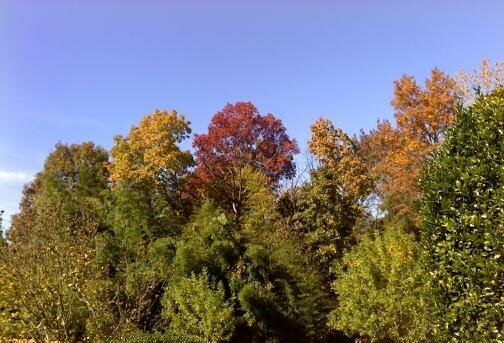 |
There is no mistaking autumn in North Carolina. Simply look to the color in your backyard or stroll down one of the many neighborhood streets in Charlotte adorned with maples, hickories, and capacious oak trees putting on brilliant shows of color! But what causes the leaves to change then drop, and how can we take advantage of this in our landscape?
The shortening day lengths, combined with chilly nights and sunny afternoons, trigger the breakdown of chlorophyll production in leaves. Chlorophyll is the pigment that allows for photosynthesis and gives leaves their green color. When production of chlorophyll breaks down, the remaining pigments in the leaves show through. The scarlet reds produced by sourwoods are the result of anthocyanins, pigments formed when sugars are trapped in leaves on cool nights. Pigments like carotenoids and flavanols, hidden by chlorophyll in the summer, produce brilliant displays of yellow and orange in species like birch, hickory, and maple.
Coinciding with the changing color, deciduous trees send a hormonal response triggering their leaves to fall off in preparation for winter. These fallen leaves then become excellent habitat for wildlife or the perfect landscaping mulch for your garden. Enjoy!
Photos courtesy of EMG Gina Tadle
| |
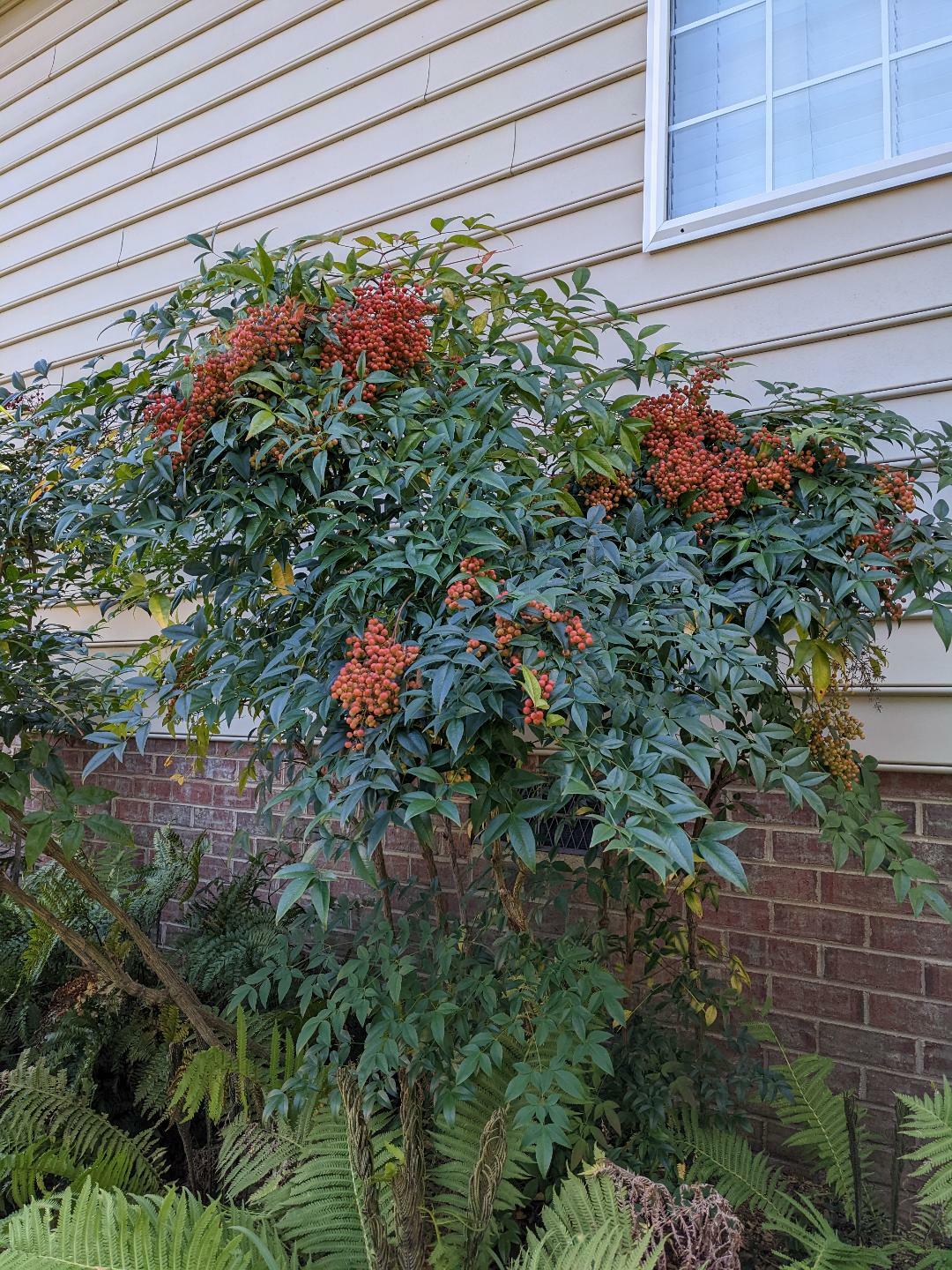 |
Nandina, or ‘Heavenly Bamboo,’ is a lovely plant with many virtues. It has pretty berries, a graceful form, and is evergreen. However, we are discouraged from planting it and encouraged to remove it from our yards. Nandina is listed in the Invasive Plant Atlas of the United States and is regarded as invasive throughout the Southeastern United states. Not only is it considered to be a non-native invasive plant, but the berries contain arsenic and can kill birds if they eat too many. When I moved to Charlotte, which was a new ecosystem for me, our house had a hedge of nandina across the front porch. I loved it! But as I learned more, I started removing them, which turned out to be not that easy. If you dig them up, they will return from specks of roots left behind. New volunteers continue to pop up in my shrubbery in the wooded area of my yard, justifying for me their inclusion on the list of invasive plants. If you succeed in removing yours (a dab of herbicide on the cut stump seems to do it) and you still want a shrub with berries, our native Winterberry Holly is a good choice, as is our native American Beautyberry. If you choose to keep your Nandina, please consider cutting off the berries so the birds don’t eat them and the plants won’t spread.
Photo courtesy of EMG Stacy Hodes
| |
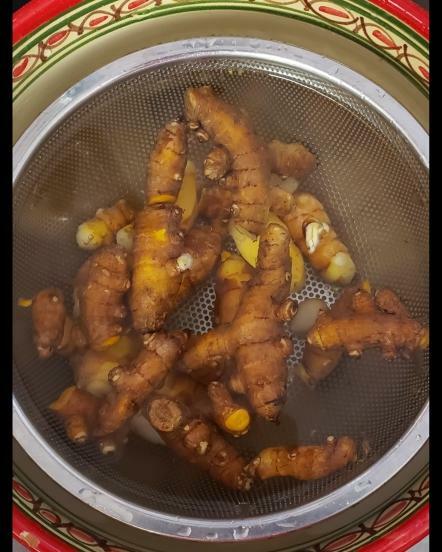 |
This popular spice from the Indian subcontinent that lends a typical yellow color to anything it is added to, comes from the rhizome of the Turmeric plant. At first glance, the plant looks a lot like Canna. Hardy in Zone 8 and above, it is a fuss-free plant that does well in varying sunlight availability - from dappled sunlight, partial shade to full sun. The genus name 'Curcuma' is Latin, from the Arabic word 'Kumkum or Saffron'. It acquired the name because the color of the plant's rhizome resembles Saffron. But the two plants couldn't be more different as Saffron is the filament of the Saffron Crocus!
Turmeric belongs to the family Zingiberaceae - where yet another popular spice, Ginger, comes from. Ginger is more commonly used fresh, unlike Turmeric which is more popular in its powdered form. Both have incredible anti-inflammatory properties and their medicinal usage can be traced back thousands of years, as mentioned in Ancient Ayurvedic remedies. Both of the plants are very easy to start, even from grocery store produce. Simply bury the rhizomes shallowly (it doesn't matter which side up) in late spring once the soil is workable, and green growth will be visible above ground after about 6 to 8 weeks. Enjoy growing these plants, both for their looks as well as their medicinal uses.
Photos courtesy of EMG Parul Srivastava
| |
Peonies - Caring and Sharing
| |
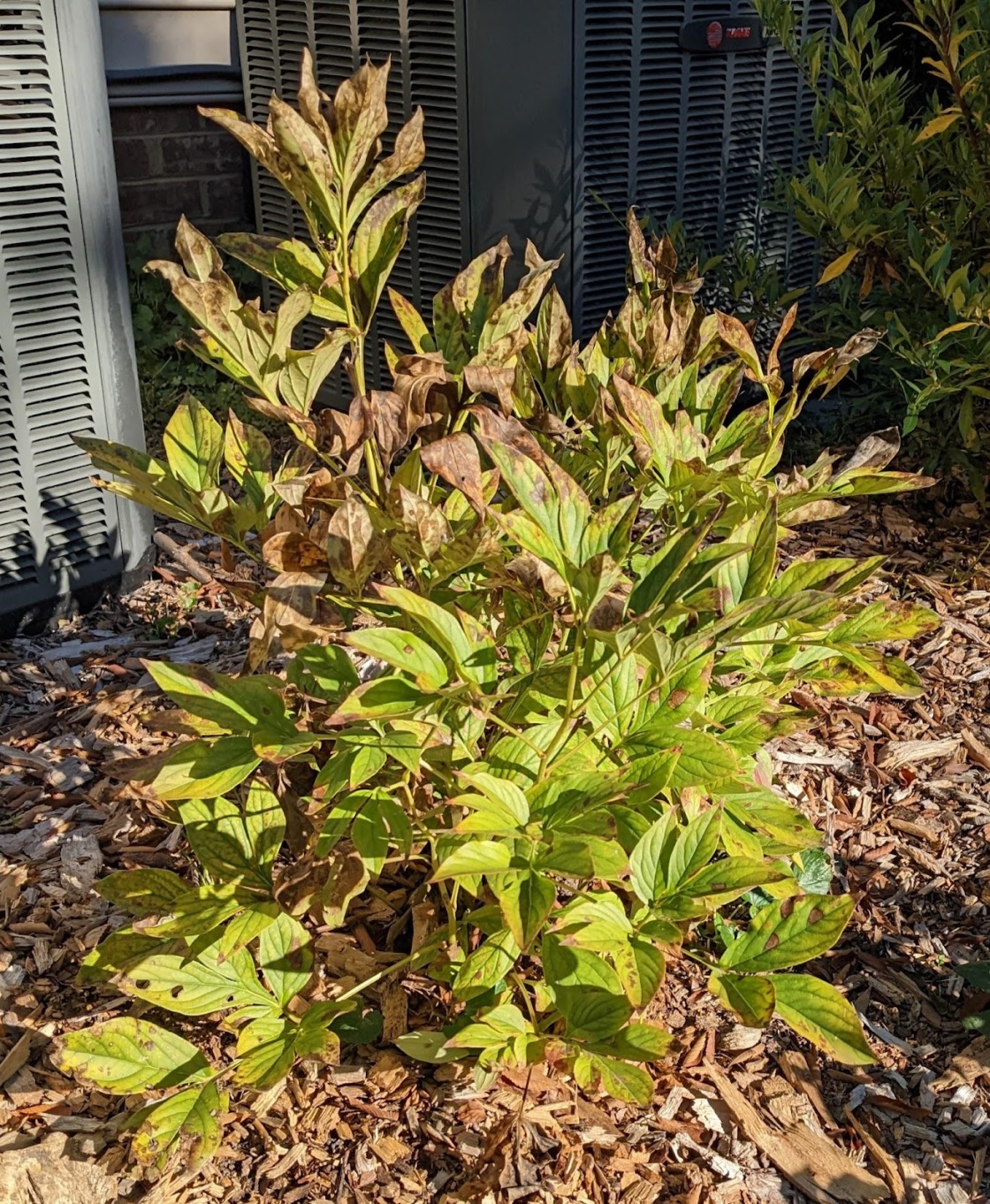 |
Your herbaceous peonies have brought you such beautiful blooms this season but now the plants are starting to look a bit sad. They are ready for their long winter’s nap! The first thing you will want to do is remove and destroy the old mulch around the plants to fend off diseases. Leave the plants unmulched during the winter. They need exposure to cold temperatures to bring on blooms next season. Then, after the first frost, remove stems down to 3 inches from the surface of the soil to help avoid fungal diseases. If you have plants that are 10-15 years old and you are ready to share with friends, this is the best time to divide them. You will want to gently dig around the plant so you don’t cut any roots. Peonies have tubers so, with a sterilized sharp knife, cut sections containing 3 to 5 eyes. It’s good to treat each cutting with a fungicide to avoid disease. If you want to introduce peonies into your garden or just need more information, we've provided additional resources.“ A rose is a rose, but a peony is a friend forever.” Author unknown
Resources:
NC State - Peonies for the Home Landscape
Instructional Video from Thompson and Morgan - How to Plant Peonies
Photos courtesy of Stacy Hodes and Pixabay
| |
Tucking in Plants for the Winter | |
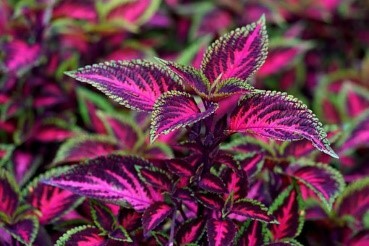 |
Porch plants soon become houseplants again as winter approaches. Here are some tips for successful transitions.
Freshen up potted plants. Trim excess growth, especially if plants became too large for your indoor space. Examine leaves for aphids, mealy bugs, and white flies. Remove all mulch to be sure no frogs are lurking. Using a mild dishwashing soap solution, dunk small plants. Spray top and bottom of leaves of larger plants. It’s fine to let soap drip into the soil. Scrub the pot or repot.
Start cuttings for next year. 4-inch cuttings of begonias and coleus, for example, can be rooted to enjoy over the winter; then, they are ready to plant outdoors in spring.
Dig up geraniums. Shake the soil from the roots and prune any unhealthy stems. These can overwinter in paper bags or cardboard boxes and stored in a cool place that does not freeze (the top of an outdoor refrigerator, a crawl space, or a garage). Plants like hibiscus can be stored in their pots next to the geraniums.
Mulch in-ground plants. Wrap cardboard, wire mesh, or plastic around potted plants and fill the cylinder with mulched leaves or straw. Shelter the pots together on a south-facing wall.
Now our plant pets are all tucked up for the winter.
Photos courtesy of Pixabay
| |
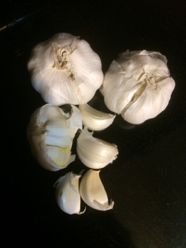 |
Grow Garlic Like a Pro
Growing garlic is as easy as pushing the garlic bulb cloves down into the soil. However, here are a few simple tips to know first.
- Don’t use supermarket garlic. It has been treated to prevent premature sprouting and to kill pathogens. Consider ordering your garlic or getting organic garlic from the farmer’s market.
- Break the garlic bulb down into cloves, leaving the skin on. Plant the cloves in rich organic, well-drained soil in full sun. Do not plant garlic in an area where you have grown garlic or onions in the previous year.
- Plant cloves point side up, 1 inch deep and 4 inches apart, and water in.
- Water well when the soil is dry or roughly 1 inch a week.
- Fall plantings will be ready to harvest in the spring when the foliage is turning yellow.
- Allow harvested plants to dry in the sun for a few hours and then spread them out in a well vented area until the tops are fully dry. This will take 3 – 4 weeks.
- Store bulbs in a cool, dry place. Garlic can also be frozen.
Photos courtesy of NCSU
| |
|
|
Like our content? Share it with friends and neighbors! They can subscribe here. | |
Follow us on Social media | |
|
|
|
|
The Mecklenburg Extension Master Gardener Volunteer (EMGV) program operates under the Mecklenburg Center of the NC Cooperative Extension Service (NCCES), a part of NC State University and NC A&T State University.
NCCES is a part of Mecklenburg County Park and Recreation.
| |
| |
|
NC State University and N.C. A&T State University commit themselves to positive action to secure equal opportunity and prohibit discrimination and harassment regardless of age, color, disability, family and marital status, gender identify, genetic information, national origin, political beliefs, race, religion, sex (including pregnancy), sexual orientation and veteran status. NC State, N.C. A&T, U.S. Department of Agriculture, and local governments cooperating. | |
|
|
| |
|